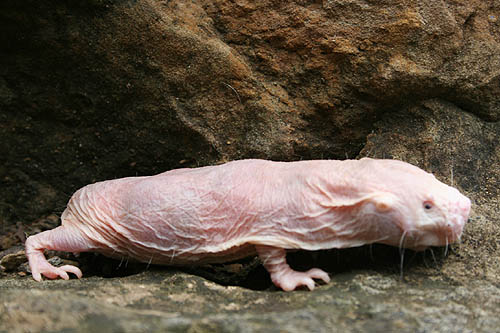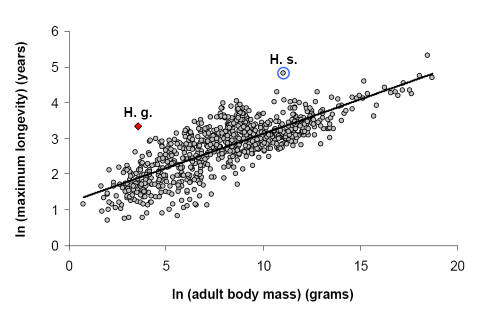The naked mole rat (or Heterocephalus glaber) (see figure 1) is a strange mammal. As their name already implies, they have little hair. Furthermore, their eyes are very small and their visual abilities are mediocre at best. This naked rat is one of only two eusocial mammals (the other one being the Damaraland mole rat, or Fukomys damarensis), with a lifestyle similar to social insects. Living in underground colonies, ruled by the only reproductive female (the ‘queen’), the work is performed by non-reproductive females. A few males hang around, mating with the queen. They live in a huge network of burrows, where they browse around in search of plant tubes, which they eat (see video).

Figure 1: the naked mole rat (Source: Naked Mole-Rat Genome Resource)
Video: A little more about the naked mole-rat. (Source: New Scientist TV, Naked and ugly, the new face of lab rats)
But beyond their appearance and lifestyle, there are other features that set these creatures apart from most of their mammal relatives. They can get by with remarkable little oxygen and seem to be fairly impervious to chemically induced pain. But wait, there is more. Naked mole rats appear to be highly resistant to the development of cancer. So far, no individual with any form of cancer has ever been observed. A potential explanation for this, is the fact that these creatures posses a double barrier (genes p16 and p27) to unwanted cell proliferation (Seluanov et al., 2009). And finally, naked mole rats are remarkably long-lived for their size (see figure 2). Living for about 30 years, they are the rodent record-holders for old age. An idea for the cause of their remarkably long life, is that they are very efficient and quick at recycling proteins, keeping their systems running in great shape (Pérez et al., 2009).

Figure 2: Plot of the relationship between maximum longevity and adult body mass (n = 820). The blue dot is Homo sapiens and the red diamond the naked mole rat, Heterocephalus glaber. (Source: Naked Mole-Rat Genome Resource)
This longevity has been the main driving force behind an international effort to sequence the genome of this enigmatic rodent. And now, a draft genome has been made available at the Naked Mole-Rat Genome Resource.
Will be continued...?
References
Pérez, V.I.; Buffenstein, R.; Masamsetti, V.; Leonard, S.; Salmon, A.B.; Mele, J.; Andziak, B.; Yang, T.; Edrey, Y.; Friguet, B.; Ward, W.; Richardson, A. and Chaudhuri, A. (2009). Protein stability and resistance to oxidative stress are determinants of longevity in the longest-living rodent, the naked mole-rat. PNAS. 106(9), pp. 3059 – 3064.
Seluanov, A.; Hine, C.; Azpurua, J.; Feigenson M.; Bozella, M.; Mao, Z., Catania, C.K. and Gorbunova, C. (2009). Hypersensitivity to contact inhibition provides a clue to cancer resistance of naked mole-rat. PNAS. 106(46), pp. 19352 – 19357.




Comments